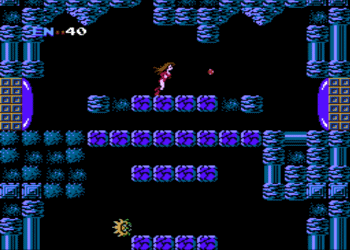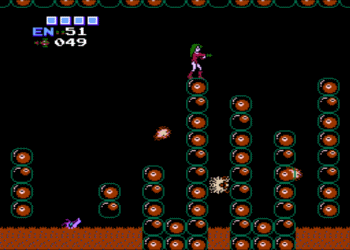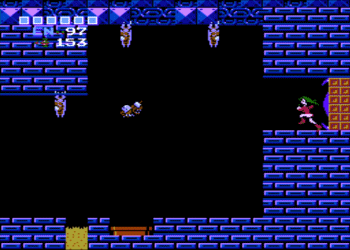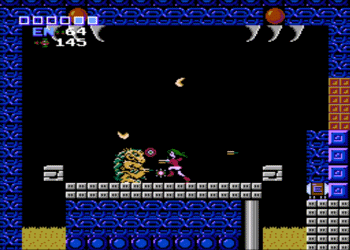Samus looks okay straight on, but when she turns sideways and starts jumping around the sprite just looks stupid with its oversized red helmet and yellow spindly legs.
A password system theoretically allows players to pick up approximately where they left off, but I find it far more entertaining using it to get weird configurations of items.

See the blue door on the left? That’s the very first door in the game. See the funny blocks under Samus? Those are breakable. See the enemy at the bottom of the screen? Notice how it informs you, “Hey, something is down here!”
By the way, that something is Kraid’s lair. ![[CENSORED COMMENTS regarding the BLEEPITY-BLEEP-BLEEP-BLEEP mother BLEEPing piece of BLEEP that put this BLEEP in the game! BLEEP you! BLEEP you to BLEEP! FUUUUUUUUUCK!] metroid_03](metroid/metroid_03.gif)
To escape from this evil dead end, you have to shoot out the destructable blocks (which reappear after a few seconds) while jumping around the solid blocks while not getting hit by the flying enemies. Oh, and there’s five tiers of these things.

Notice Samus has green hair here. That means she has the Varia Suit. That means if she falls into the inescapable lava pit in front of her, she'll spend the next fifteen minutes boiling to death which, by the way, is still an infinitely better usage of time than farming for five-hundred energy.
Review by Jay Wilson My first experience with the Metroid series came in 1991 with Return of Samus on the Nintendo Gameboy. And I recall at the time, while several of my friends also owned Metroid II, none of us had ever seen or even heard of Metroid 1. A few years later, when the legendary Super Metroid was still just a couple of grainy leaked photos in Electronic Gaming Monthly, I finally ran into someone who not only played the original, but actually owned it. I promptly borrowed it and after about twenty minutes play ... returned it. Decades later, I would come back to Metroid with an open mind and force myself to stick with it out of love for the franchise, hoping against hope that I judged it too quickly, too harshly, and would discover a deserving classic. Instead, I ended up unearthing reasons to not only disliked bounty hunter Samus Aran’s first clash with the space pirates of planet Zebes, but also despise it. In essence, Metroid attempts to fuse the short term platform game (a la, Super Mario Bros.), which is intended to be beaten in a single sitting, with the long term style adventure game (a la, The Legend of Zelda), which is intended to be gradually explored over the course of days, weeks, or even months. While these two styles can work harmoniously together, in Metroid they constantly clash, creating a design counterintuitive to both short term and long term play. For starters, Samus begins with a crappy cannon that has a range of a whopping fifty pixels. Fifty. A little less than twenty percent of the screen. Now, I don’t expect to start out with the most powerful gun, but I do expect the “greatest of all the space hunters” to have something with more range than, say, a water pistol. On top of that A. Samus cannot shoot at angles, but enemies often fly around, drop from the ceiling, or spawn infinitely from wells and track Samus so they literally come at her from every angle. B. Samus cannot shoot straight down but frequently has to descend long vertical shafts meaning she has no way to kill enemies beneath her. And C. Samus cannot crouch and shoot, but the developers put in an abundance of small enemies that crawl along the floor under the path of most of her beams, and even Screw Attack disengages before it can kill them. Translation: Samus cannot deal with most of the scenarios she’ll face. Doesn’t sound like good game design, does it? Much less a design that encourages wandering around and facing said scenarios for hours on end. But the nail in the coffin all those years ago was that Samus begins play with thirty energy (health) even though she has the capacity for ninety-nine. Less than one-third. As she explores more areas and racks up energy tanks, she gains the capacity for seven-hundred energy. But no matter how much she explores, no matter how many energy tanks she picks up, no matter how many enemies/mini-bosses she defeats, if you turn the game off and/or die Samus will begin play with only thirty energy, which means in certain parts of the game, enemies can kill her in two hits. While two-hit kills can work in, say, Mario—a single sitting game—it doesn’t exactly lend itself to long term play across multiple sessions. Contrast this with Legend of Zelda, released the same year. At the beginning of the adventure, Link starts with three hearts (health), and all three hearts are full, which allows Link to throw his sword across the entire screen, which lets Link deal with pretty much anything up to and including the third dungeon (ie, Link can start exploring immediately). Later on, if you power off or die after Link has acquired more heart containers, he still starts out with only three full; however, the game also provides potions, fairies, and fairy pools to quickly get Link up to full health and get him back to exploring Hyrule. As for poor Samus? She’s farming for energy from screen one, and the only fast way to restore large quantities is to find an energy tank of which there’s only eight (and they’re non-reusable). So, unless you have the foresight to leave an energy tank specifically for a password continuation later (which is what the famous Justin Bailey password does, among other things), Samus will spend most of the game farming for health ... but how are you supposed to know that on your first playthrough? Granted, the low starting health and limited energy tanks don’t matter if you can play beginning to end, uninterrupted, but Metroid does not lend itself to single sitting deathless playthroughs the first time around because planet Zebes is a frickin’ maze with confusing identical corridors, an abundance of dead-ends, locked doors, and secret passages—all of which require exploration, which requires time—and a few malicious stretches of the game are deliberately designed to screw the player. Let’s talk about Kraid’s lair, one of the hardest areas of the game. The passageway leading to Kraid’s domain is the second screen the player sees. You can’t get to it yet because you need the bombs, but the floor is obviously destructible. To survive Kraid’s lair, however, Samus needs the Varia Suit, which halves damage because enemies take off twenty energy per hit (and remember, she starts with only thirty). As soon as Samus gets the bombs, she can go straight to Kraid’s lair and die, and she probably will because to get the Varia Suit she needs to get the bombs in Brinstar, go to Norfair, bomb an unmarked section of floor, go through a door, get the High Jump Boots, climb back up, go back to Brinstar, bomb an obvious destructible block in the wall, shoot an unmarked section of ceiling, and use the High Jump boots to get through the doorway where the Varia Suit awaits. In other words, the developers laid out a red carpet leading the player to an area they’re not ready to survive while simultaneously hiding the very things needed to survive it. 
This exact screen shows up not once, not twice, not three times, but ten—yes, TEN—times in Kraid’s lair. One leads to Kraid, two lead to missile packs, and seven lead to nowhere.

Samus finds significant game-altering powerups (such as Bombs, Beam upgrades, High Jump Boots, Varia Suit, and Screw Attack) on the palms of Chozo Statue.

The only two reasons to venture into Kraid’s domain: Kraid himself and an energy tank ... and since at this point I’ve maxed out my health, I don’t need the energy tank.

You might think those projectiles are spreading out from their point of origin, but no. They are all following the same path which, as you can see, clearly arc over Samus’ head.
That is bullshit. In Legend of Zelda, the entrances to the harder labyrinths are hidden, and many of them require the treasure found in a previous labyrinth to access. Thus each area, dungeon, and challenge prepares you for the next one. Look at level six, unanimously considered the hardest dungeon next to Death Mountain because the Wizzrobes are a nightmare by any gamer’s account. The magic shield makes them much easier to contend with. Where do you find the magic shield? Pretty much any shop in the game. There’s one on the third screen. Go north, go west, go in the cave. Boom. Ten seconds. Didn’t even have to kill anything. You can go there before you pick up the wooden sword if you want to. The player is guaranteed to find one if they bother to look around. Where’s level six? Fourteen screens away. You either have to get the raft from level three to get the ladder from level four which takes you past level one where you pick up the bow that allows you to beat Gohma (level six’s guardian) or you can solve the puzzle of the Lost Woods which takes you by level three which takes you through the cemetery where you can pick up the magic sword and finally arrive at level six. Do you see the difference between this and Metroid? In Legend of Zelda, you can do stuff out of order if you want to. You can stumble upon level six before you’re ready if you get carried away exploring. But here’s the thing: you have to go out of your way to find it. If you get to Gohma without the bow and arrow, that’s your problem. That’s your failure. What makes Kraid’s lair even worse? It’s completely pointless. The first door you come to on the right takes you to a missile pack. Get the missiles and go back. Don’t go any further even though the corridor keeps going. It leads to a vertical shaft which leads to three doors leading to three enemy infested corridors leading to another vertical shaft that circles back to where you just came from. In other words, there are fifteen screens worth of absolutely nothing through the first fucking door. First door. Don’t even bother going left. Screen after screen, corridor after corridor, vertical shaft after vertical shaft serve no purpose. Are there any major items in this neck of planet Zebes? No. Not one. Every single one is in either Brinstar or Norfair. Boss areas only have two energy tanks and a couple missile packs each. And most people who replay Metroid take out Ridley first because everything is over there by him anyway, which means when they do come back for Kraid, they’re already ready to fight Mother Brain. Killing Kraid is just a formality. If you could get to Tourian without fighting Kraid, there would be no reason to come down here at all. But, again, when you play Metroid for the first time, you have no way of knowing that none of these doors have a payoff. Yet again, contrast this with Legend of Zelda where each labyrinth has a new item that gives Link new abilities. The Legend of Zelda rewards the players. Those rewards motivate us to keep exploring because we feel our time is justified. I vividly recall getting the candle and using it to burn some Moblins in the forest because if you did it right and pinned them to the side of the screen they would keep walking into the flame and die. Well, a tree happened to be nearby which burned, uncovering the secret entrance to a new shop. So you know what I did? I went on a mission to burn every single tree in Hyrule. A waste of time? You bet, but I did it. And I was happy to do it. I burned every tree that flame could reach—hell, I even stared at distant trees and thought at length of ways to get to them. And do you know what happened? I found the entrance to The Lion, also known as level eight, way before I was supposed to. You know what else? I went inside and got the magic book, which has no purpose without the magic wand, which I did not have yet, but it was still fucking awesome because, whatever it was, I wasn’t supposed to have it yet. Metroid actually manages to make finding new stuff suck. First of all, some so-called power ups elevate Samus Aran, the supreme bounty hunter extraordinaire, from pathetically underequipped to mildly competent. “Great, after three hours I have the long beam now; I can shoot clear across the screen, which I should have been able to do from the very beginning.” You find bombs which lets you kill enemies crawling on the floor in an incredibly impractical and clunky way, but, more importantly, they open up secret passages, which should really pave the way for finding the “good” stuff right? The Wave Beam? The Varia Suit? And let’s not forget the almighty Screw Attack. So on the return trip, there’s a room where the player will notice an enemy under the floor. Bomb the floor, go down, find the Ice Beam. Cool! That’s how it should work, right? Now you’ve been rewarded, so you’re encouraged to try it again. Two rooms later there’s an identical screen with an identical enemy under the floor. So now you can’t resist bombing the floor, going down, and getting trapped in a dead end that’s damn near impossible to escape from. 
The game’s namesake only shows up in Tourian, Mother Brain’s territory. To kill a metroid, you have to freeze it and then unload five or six missiles into it.
I actually love the battle with Mother Brain. I love fighting my way to it, breaking through the Zebetites along the way. I love that Mother Brain, itself, doesn’t attack; rather, automated defenses around the room fire on Samus.
It’s no accident these secret passages are virtually side-by-side. It’s no accident they occur in the order they do. Someone planned this with the deliberate intention of luring the player into an empty, pointless, and difficult to escape chamber on the promise of a reward that never materializes. Neither is it an accident that Kraid’s domain is out in the open while the Wave Beam, Screw Attack, and Varia Suit are buried in the farthest reaches of Brinstar and Norfair. The game is out to get you, which is fine, by the way, in single sitting games like Castlevania, Ninja Gaiden, and, hell, even Megaman. Do you know why? Because the traps in those games just kill you. Start over, and try again. That’s what you do in Castlevania. But in Metroid you’re supposed to roam and wander. You’re supposed to come upon new doors and say, “I want to see what’s behind that!”, gaze up at ledges beyond your reach and think, “One day I’m getting up there’, and blow open secret passages while breathlessly exclaiming, “I can’t wait to see where this goes!” even before the dust has settled. You’re supposed to throw caution to the wind and dive headfirst into the beckoning unknown. You’re supposed to explore ... | |||||||||||||||||||||||||||||||||||||||||||||||||||||||||||||||||||||||||||||||||||||||||||||||||||||||||||||||||||||||||||||||||||||||||||||||||||||||||||||||||||||||||||||||||
|
| |||||||||||||||||||||||||||||||||||||||||||||||||||||||||||||||||||||||||||||||||||||||||||||||||||||||||||||||||||||||||||||||||||||||||||||||||||||||||||||||||||||||||||||||||
